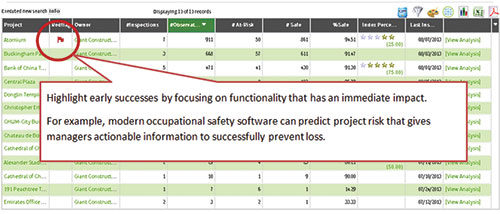Introducing safety software
We are introducing new occupational safety software to our employees. How can we ensure it is adopted successfully?

Responding is Nick Goodell, process improvement leader for Safety Net software, Predictive Solutions, Pittsburgh.
It is no surprise that early research into organizational change by management began by studying how people respond to grief. Typically, new software projects involve upper management, which budgets for the financial side of a project and doesn’t account for the human impact. A lot of good research into techniques, with varying approaches, can be applied to introducing occupational safety software in your company.
Multiple studies show that more than 50 percent of all software projects fail. Companies that get it right quickly can profit from a sustainable competitive advantage. Here are a few tips that have worked for us in the adoption of occupational safety technology:
- When your team knows why you are introducing something new, the group is more likely to promote its success. Involve all stakeholders early in helping define product requirements, vendor selection and decisions. Begin with the end in mind and gather consensus into what your future state should look like. Teams more successfully adopt occupational safety software when they know the project outcome supports your company mission, values, data management strategy and safety culture.
The formal process of developing a vision, strategy and plan ensures alignment and gives your company a concrete benchmark with which to measure future results. Align the team around specific shared goals, such as predicting injuries, developing safety leading indicators specific to your projects, or supporting a behavior-based safety program. The corporate world has much lingo to describe breaking large projects into smaller tasks that build toward bigger goals: “Crawl, walk, run (then fly),” “Eat the elephant one bite at a time,” etc. Our experience has shown there are great benefits to introducing enterprise-level occupational safety software in smaller stages. Start using the software with a single team working on a simple project. Enter data for a single job safety assessment, BBS observation or construction site safety audit. One thing at a time, but with a measured sense of urgency to keep your safety management software rollout on track. - Highlight early successes by focusing on functionality that has a visible impact to an entire process. For example, make a simple safety observation or incident record electronically and publicize how the new tools for data capture created efficiency, accuracy and automated reporting. Users will progress more rapidly through the change management curve and more easily embrace future phases of the project when they find early wins and understand how their individual efforts work toward the team’s success.
Although it would be great to start your project by automating delivery of that report that takes you a week to compile, resist the temptation to start with functionality that ignores project dependencies, only benefits a limited audience or may be too complex.
Good industrial safety software provides much more than just the functionality of the product – it is the experience of your supply partner with knowledge of your company and industry. Adoption of the best workplace safety software will fail to reduce workplace injuries if it is not in harmony with your processes and people. Taking the right steps early in the planning and rollout stages of your project will move you closer toward acceptance and minimize the risk of failure.
Editor's note: This article represents the independent views of the author and should not be construed as a National Safety Council endorsement.
Post a comment to this article
Safety+Health welcomes comments that promote respectful dialogue. Please stay on topic. Comments that contain personal attacks, profanity or abusive language – or those aggressively promoting products or services – will be removed. We reserve the right to determine which comments violate our comment policy. (Anonymous comments are welcome; merely skip the “name” field in the comment box. An email address is required but will not be included with your comment.)

